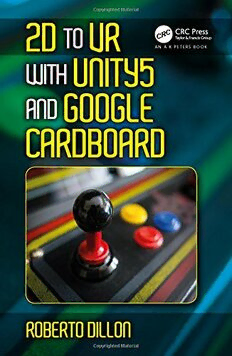Table Of Content2D to VR with Unity5 and
Google Cardboard
2D to VR with Unity5 and
Google Cardboard
by
Roberto Dillon
CRC Press
Taylor & Francis Group
6000 Broken Sound Parkway NW, Suite 300
Boca Raton, FL 33487-2742
© 2017 by Taylor & Francis Group, LLC
CRC Press is an imprint of Taylor & Francis Group, an Informa business
No claim to original U.S. Government works
Printed on acid-free paper
International Standard Book Number-13: 978-1-4987-8152-7 (paperback)
978-1-138-62886-1 (hardback)
This book contains information obtained from authentic and highly regarded sources. Reasonable efforts have
been made to publish reliable data and information, but the author and publisher cannot assume responsibility
for the validity of all materials or the consequences of their use. The authors and publishers have attempted to
trace the copyright holders of all material reproduced in this publication and apologize to copyright holders if
permission to publish in this form has not been obtained. If any copyright material has not been acknowledged
please write and let us know so we may rectify in any future reprint.
Except as permitted under U.S. Copyright Law, no part of this book may be reprinted, reproduced, transmitted,
or utilized in any form by any electronic, mechanical, or other means, now known or hereafter invented, includ-
ing photocopying, microfilming, and recording, or in any information storage or retrieval system, without writ-
ten permission from the publishers.
For permission to photocopy or use material electronically from this work, please access www.copyright.com
(http://www.copyright.com/) or contact the Copyright Clearance Center, Inc. (CCC), 222 Rosewood Drive,
Danvers, MA 01923, 978-750-8400. CCC is a not-for-profit organization that provides licenses and registra-
tion for a variety of users. For organizations that have been granted a photocopy license by the CCC, a separate
system of payment has been arranged.
Trademark Notice: Product or corporate names may be trademarks or registered trademarks, and are used only
for identification and explanation without intent to infringe.
Library of Congress Cataloging-in-Publication Data
Names: Dillon, Roberto, author.
Title: 2D to VR with Unity5 and Google Cardboard / Roberto Dillon.
Description: Boca Raton : Taylor & Francis, CRC Press, [2017]
Identifiers: LCCN 2016035592 | ISBN 9781498781527 (pbk. : alk. paper)
Subjects: LCSH: Computer games--Programming. | Unity (Electronic resource) |
Video games--Design. | Three-dimensional display systems. | Virtual
reality. | Google Cardboard (Three-dimensional display system)
Classification: LCC QA76.76.C672 D5338 2017 | DDC 794.8/1526--dc23
LC record available at https://lccn.loc.gov/2016035592
Visit the Taylor & Francis Web site at
http://www.taylorandfrancis.com
and the CRC Press Web site at
http://www.crcpress.com
To Marina (1973–2007) and Davide (1973–2016)
Contents
Foreword, ix
Introduction, xi
Acknowledgments, xiii
Author, xv
Section i Our First Game
chapter 1 ■ Getting Around in Unity 3
chapter 2 ■ Setting Up a Platform Game 13
chapter 3 ■ Running and Jumping 33
chapter 4 ■ Sound and More 53
chapter 5 ■ Scoring and Final Touches 65
Section ii Building a Match 3 Game for PC and Mobile
chapter 6 ■ Game and Music Managers 79
chapter 7 ■ “Jem Matcher:” Part 1 101
EXERCISE 1 120
EXERCISE 2 120
chapter 8 ■ “Jem Matcher:” Part 2 121
EXERCISE 130
vii
viii ◾ Contents
chapter 9 ■ Moving to Mobile 131
EXERCISE 138
Section iii Developing a 3D Game for PC and VR
chapter 10 ■ Terrain and First Person Character 141
chapter 11 ■ Enemies and Path Finding 157
chapter 12 ■ Introduction to VR and Google Cardboard 177
chapter 13 ■ Porting to VR 189
Section iV Advanced Topics
chapter 14 ■ Physics 205
NEWTON’S FIRST LAW 205
NEWTON’S SECOND LAW 209
Simulating Gravity 211
NEWTON’S THIRD LAW 212
EXERCISES 218
chapter 15 ■ Introduction to Shaders 221
chapter 16 ■ Setting up Unity Ads, IAPs, and Analytics 235
INDEX, 247
Foreword
I was probably in primary school when i started dreaming about
making games. In my head, games where made of ideas spawned from
the imagination of the game designer, ideas that would be magically
implemented in the software by the programming team. I wanted to be a
game designer, and I thought programming was not something I had to
dabble with.
Later on I found out that entering the game industry as a game designer
was quite complicated because of the typical “Catch-22 dilemma:” nobody
hires a designer without prior experience in the industry, but at the same
time it’s impossible to get industry experience without being in the indus-
try in the first place. For somebody who couldn’t afford to come out of a
game design school, this was quite the problem.
My first foray into real game-making was using Adobe Flash around
2007. For the first time, Flash was allowing me to be the game designer,
programmer, and even graphic artist, bridging the gap between my ideas
and making them a reality that thousands of people could actually try.
The way games are made today is wildly different and this is true mostly
thanks to the incredible pieces of software we have available. In time,
game engines like Unity, Unreal Engine, Game Maker, Stencyl, Construct
(and many others) had expanded on what Flash enabled in the first place,
becoming a necessary tool to cope with the ever-changing landscape of
platforms, consoles, technologies, and requirements. After Flash, in 2012
I chose Unity as my engine of choice for its flexibility and ease of use, and
the huge community and amount of online resources and books available
to learn.
I now work at Unity Technologies, and I am amazed every day by how
fast the panorama changes and how quickly the company—and thus,
the engine—reacts to it. New stores coming out everyday, new platforms,
VR, rendering technologies, new controllers, new ways to monetize, a
ix

